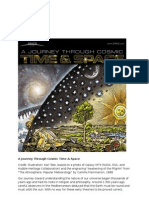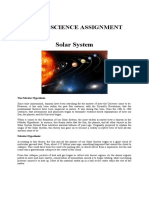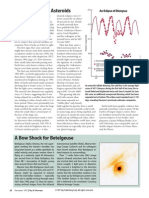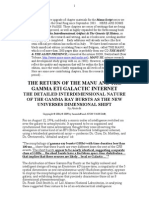Astronomy
Astronomy
Uploaded by
sd_samipCopyright:
Available Formats
Astronomy
Astronomy
Uploaded by
sd_samipCopyright
Available Formats
Share this document
Did you find this document useful?
Is this content inappropriate?
Copyright:
Available Formats
Astronomy
Astronomy
Uploaded by
sd_samipCopyright:
Available Formats
Introduction For astronomy 1993 was a year of discovery but also one of bitter disappointment. The U.S.
Mars Observer spacecraft, eagerly anticipated for its ability to make the first close-up observations of Mars in 17 years, suddenly fell silent on August 21, three days before it was to go into orbit around the planet. The Hubble Space Telescope (HST) produced many new optical images of astronomical objects but was plagued by problems with pointing, power, and a flawed primary mirror. At year's end space shuttle astronauts successfully completed the most elaborate repair mission in the history of the U.S. space program to fix the telescope, although the results of their work would take weeks to evaluate. On the positive side, observations from several spacecraft provided insights into a variety of phenomena, and to cap the year two American astronomers from Princeton University, Russell Hulse and Joseph Taylor (see NOBEL PRIZES), were awarded the Nobel Prize for Physics for their discovery and subsequent study of a binary pulsar, a rapidly spinning neutron star in orbit with another star around a common centre of gravity.
Solar System. Although the solar system is dominated by the Sun and major planets, some of the more exciting revelations of 1993 involved comets and asteroids. In March a spectacular comet was discovered by Carolyn and Eugene Shoemaker of the U.S. Geological Survey, Flagstaff, Ariz., and David H. Levy of the University of Arizona. The most unusual feature about Comet Shoemaker-Levy 9 was that it looked like a string of glowing pearls. An HST photograph revealed about 20 cometary chunks spread out in a line. Calculations suggested that the comet's nucleus broke up after a near collision with the giant planet Jupiter in July 1992 and predicted that the pieces would plunge into Jupiter's atmosphere about July 20, 1994, unleashing an energy equivalent to roughly 100 million megatons of TNT. In 1991, as the Galileo spacecraft passed near the asteroid Gaspra en route to Jupiter, it snapped the first close-up picture of an asteroid. In August 1993 Galileo passed and imaged a second asteroid, 243 Ida. An elongated object about 52 km (32 mi) across, Ida is heavily cratered, suggesting it is at least a billion years old. While passing Ida, Galileo's onboard magnetometer detected shifts in the direction of the magnetic field of the local solar wind. Since the solar wind consists of electrically charged particles blowing
away from the Sun and dragging the magnetic field along with it, the measurements suggested that Ida possesses its own magnetic field, which distorts the solar wind field. Where do comets come from? For years astronomers have postulated a comet storehouse beyond the orbit of Pluto. According to theory, objects lying in this socalled Kuiper belt would occasionally be perturbed by encounters with nearby stars, thereby hurtling fresh comets into the inner solar system. In 1992 David Jewitt of the University of Hawaii and Jane X. Luu of the University of California at Berkeley discovered an object, designated 1992 QB1, that seemed to be part of this belt. In early 1993 the two astronomers reported a second body, dubbed 1993 FW, lying at what may be the belt's inner edge. By October four more objects had been spotted, although these appeared to lie somewhat closer in, just outside Neptune's orbit. It may be that the latter objects are comets that have left the belt and are moving inward toward the Sun; alternately, they may be asteroids having permanent residence near Neptune.
Stars. In the early 1970s the first gamma-ray observatory satellite, SAS-2, detected a bright gamma-ray source
with no obvious optical counterpart. Its discoverers called the object Geminga (Milanese Italian dialect for "it's not there"), but its nature remained a mystery until 1992 when detection of periodic X-ray and gamma-ray emission suggested that Geminga is a pulsar. In February, Italian astronomer Giovanni Bignami and coworkers reported that they had measured the proper motion of the object, from which they concluded that Geminga was the nearest pulsar to Earth detected to date. Their observations also supported the optical identification of Geminga with a very dim (25thmagnitude) star. Because of its rather young age of about 350,000 years and its close distance of about 300 light-years, astronomers speculated that Geminga may have had an effect on Earth when the pulsar formed in a supernova explosion. The solar system lies in a hot, rarefied region of interstellar space called the Local Bubble. The supernova that produced Geminga may have heated and thinned out matter in Earth's local region to form the bubble. The enigmatic events called gamma-ray bursts were also first detected in the early 1970s. Unlike most astronomical phenomena, these bursts, which last a few seconds or less, have never been associated with any known type of object. Nonetheless, it was widely hypothesized that the events are somehow produced by neutron stars in the Milky Way. During the year the
Burst and Transient Source Experiment (BATSE) aboard the Earth-orbiting Compton Gamma Ray Observatory (GRO) steadily detected such events, with more than 700 bursts reported by late 1993. From GRO data it appeared that there are really two classes of burst: those lasting only tenths of a second and those lasting tens or hundreds of seconds. One event on January 31 (dubbed the Super Bowl burst for its coincidence with the football event) was, while it lasted, 100 times brighter than Geminga. Although there was still no definitive identification of any gamma-ray burst with a star, quasar, or other known object, the distribution of the events over the sky is telling. Because their arrival directions are spread evenly over the sky, unlike the distribution of stars in the galaxy in which the Earth is immersed, gamma-ray bursts seem likely to come from outside the Milky Way.
Galaxies and Cosmology. Whether the observed expansion of the universe may someday stop, to be followed by a collapse, depends on the mass density of the universe. With a sufficiently high density the "closed" universe has enough gravitational pull to overcome the expansion. But the amount of matter seen in the form of visible stars, gas,
and galaxies is insufficient to close the universe. Nonetheless, many astronomers believe that the universe is closed and have been searching for the socalled dark matter that would confirm their belief. The year saw its share of proposed "sightings" of dark matter. Early on came the announcement of the detection of dark matter in a nearby group of galaxies called the NGC 2300 group. The result was derived from the detection of X-rays from this galaxy cluster by the Rntgensatellit (ROSAT) orbiting observatory. What ROSAT saw was an X-ray glow from the region around NGC 2300, presumably emitted by hot gas filling the local intergalactic space. The ROSAT team concluded that to hold the detected hot gas within the cluster, more mass than is present in the visible galaxies is required. The team reported that if the inferred dark matter also exists in other similar groups of galaxies, it would provide enough mass to close the universe. Several groups reported the detection of MACHOs (massive compact halo objects) lying within the outer reaches of the Milky Way. Astronomers believe that a halo consisting mainly of dark matter surrounds the Milky Way. It was proposed that if the halo consists of numerous small starlike objects, each too dim to be seen directly, their presence could be detected indirectly by their effects on the light from more distant visible stars. According to Einstein's general theory of
relativity, a mass will act as a lens and bend light that passes through its gravitational field. Thus, light from a more distant star would brighten and dim if a dim foreground MACHO were to pass in front of it. In 1993 a U.S.-Australian team reported detecting the predicted telltale stellar light variations. After monitoring roughly two million stars in the nearby Large Magellanic Cloud Galaxy, the team found a star that became brighter and then dimmer over a period of about a month. By year's end three more reports of such MACHO events had appeared. The nature of the unseen objects remained elusive, although candidates included brown dwarfs, red dwarf stars, and white dwarf stars. Even though the amount of matter represented by the reported MACHOs, if extrapolated to other galaxies, was insufficient to close the universe, the observational technique did open a new channel for detecting dark matter in the universe. (See PHYSICS.) (KENNETH BRECHER) -By Samip Dahal.
You might also like
- (Download PDF) An Introduction To Modern Astrophysics 2Nd Edition Bradley W Carroll Online Ebook All Chapter PDFDocument42 pages(Download PDF) An Introduction To Modern Astrophysics 2Nd Edition Bradley W Carroll Online Ebook All Chapter PDFelizabeth.taylor87288% (17)
- A GALACTIC SUPERWAVE HAZARD ALERT UPDATE - Paul A. LaViolette Nexus2009 PDFDocument16 pagesA GALACTIC SUPERWAVE HAZARD ALERT UPDATE - Paul A. LaViolette Nexus2009 PDFAnonymous 8zZGf0WkNNo ratings yet
- News Notes: Large-Scale ClusteringDocument2 pagesNews Notes: Large-Scale ClusteringbirbiburbiNo ratings yet
- PDF Docs About M100Document2 pagesPDF Docs About M100AbcdNo ratings yet
- King of The Kuiper Belt: Solar Twin Sited in ScorpiusDocument1 pageKing of The Kuiper Belt: Solar Twin Sited in ScorpiusbirbiburbiNo ratings yet
- Name - Pranay Dutt Dubey Class - 10 B Roll No - 31Document12 pagesName - Pranay Dutt Dubey Class - 10 B Roll No - 31ajita dubeyNo ratings yet
- Getting A Feel For Braille: Swallowed-Up Solar Systems?Document2 pagesGetting A Feel For Braille: Swallowed-Up Solar Systems?birbiburbiNo ratings yet
- South of Yucatan Fireball: Strange Humanoid Shape: Posted by Editorial Staff - September 30, 2013Document5 pagesSouth of Yucatan Fireball: Strange Humanoid Shape: Posted by Editorial Staff - September 30, 2013Emmanuel MarquezNo ratings yet
- Comet Shoemaker-Levy 9Document13 pagesComet Shoemaker-Levy 9haindavuduNo ratings yet
- Web - Comets Are NOT Ice DirtballsDocument8 pagesWeb - Comets Are NOT Ice DirtballsTheConscious NutshellNo ratings yet
- An Enigmatic Nebula Solved: No Vulcanoids Inside Mercury's Orbit - Yet!Document1 pageAn Enigmatic Nebula Solved: No Vulcanoids Inside Mercury's Orbit - Yet!birbiburbiNo ratings yet
- BLACK HOLE ReportDocument37 pagesBLACK HOLE ReportJhonel CastanedaNo ratings yet
- May 26, 2017 Collapsing Star Gives Birth To A Black HoleDocument14 pagesMay 26, 2017 Collapsing Star Gives Birth To A Black HoleJhonel CastanedaNo ratings yet
- Discoveries of ExoplanetsDocument375 pagesDiscoveries of ExoplanetsaillenmaeNo ratings yet
- Topic: Super Nova: Observation HistoryDocument20 pagesTopic: Super Nova: Observation HistoryJohn JovonovichNo ratings yet
- A Celestial Loner Might Be The First Known Rogue Black Hole - Science NewsDocument4 pagesA Celestial Loner Might Be The First Known Rogue Black Hole - Science NewsGouriJayanNo ratings yet
- Halley's CometDocument2 pagesHalley's CometRomel BearsNo ratings yet
- SsDocument5 pagesSsRaven SperoNo ratings yet
- InvisibleDocument6 pagesInvisibleshaniladwiNo ratings yet
- QuasarDocument12 pagesQuasarAMAN VERMANo ratings yet
- A New Dwarf PlanetDocument11 pagesA New Dwarf PlanetGian BaniquedNo ratings yet
- Study of CometsDocument8 pagesStudy of CometsMeenakshi GodaraNo ratings yet
- The Discovery of Quasars: Abstract. Although The Extragalactic Nature of Quasars Was Discussed As Early As 1960, ItDocument18 pagesThe Discovery of Quasars: Abstract. Although The Extragalactic Nature of Quasars Was Discussed As Early As 1960, ItACHINTYANo ratings yet
- Caragan Vincent M MWF: 9:30-10-30Document7 pagesCaragan Vincent M MWF: 9:30-10-30Marisa CaraganNo ratings yet
- Jupiter: (21) Kaycee Hyde Salt Lake Community CollegeDocument11 pagesJupiter: (21) Kaycee Hyde Salt Lake Community Collegeapi-284931148No ratings yet
- Solar SystemDocument9 pagesSolar SystemVishnu NatarajanNo ratings yet
- WWW Sciencealert Com The Universe S Brightest Quasar Was Hiding Two Massive Radio StructuresDocument2 pagesWWW Sciencealert Com The Universe S Brightest Quasar Was Hiding Two Massive Radio Structureskim haroldNo ratings yet
- Most Popular Satellite Mission Sputnik IDocument5 pagesMost Popular Satellite Mission Sputnik IrodrigoNo ratings yet
- Uitc 10Document5 pagesUitc 10Zselinszky ZoltanNo ratings yet
- Black Holes: Intense X-Ray Flares Thought To Be Caused by A Black Hole Devouring A Star. (Video)Document5 pagesBlack Holes: Intense X-Ray Flares Thought To Be Caused by A Black Hole Devouring A Star. (Video)Karthikeyan VenugopalNo ratings yet
- The UFO Enigma - The Other Side PDFDocument185 pagesThe UFO Enigma - The Other Side PDFSteve Durov LarkNo ratings yet
- 200106034041Document8 pages200106034041birbiburbiNo ratings yet
- DiscoveriesDocument6 pagesDiscoveriesReivajiia Naige SerbienieNo ratings yet
- JupiterDocument18 pagesJupiterCataSalvàNo ratings yet
- Asteroids, Meteors, Comets: Titles in This SeriesDocument65 pagesAsteroids, Meteors, Comets: Titles in This SeriesDiana Roxana Ciobanu100% (1)
- Planet X - 2Document6 pagesPlanet X - 2SidhanNt100% (2)
- GALAXYDocument2 pagesGALAXYBabylove GoalsNo ratings yet
- A Journey Through Space and TimeDocument22 pagesA Journey Through Space and TimeSeptian Hadi NugrahaNo ratings yet
- Better Solar-Storm Forecasting: 14:27 U.T. 14:59 U.TDocument2 pagesBetter Solar-Storm Forecasting: 14:27 U.T. 14:59 U.TbirbiburbiNo ratings yet
- Article NNNDocument2 pagesArticle NNNcrizztina13No ratings yet
- Planets Pt. 21Document10 pagesPlanets Pt. 21jpbalganion.fo2No ratings yet
- Lapurga BSES35 Activity1-1Document3 pagesLapurga BSES35 Activity1-1jerico.lapurgaNo ratings yet
- Discovery of The Planet PlutoDocument2 pagesDiscovery of The Planet Plutosayed akmalNo ratings yet
- Nats1570 Major ProjectDocument4 pagesNats1570 Major ProjectPresley AisowierenNo ratings yet
- FIGU Bulletins 2Document102 pagesFIGU Bulletins 2Lawrence JonesNo ratings yet
- Strange Moon FactsDocument2 pagesStrange Moon Factsdlazar_1No ratings yet
- Earth Science Geology AssignmentDocument52 pagesEarth Science Geology AssignmentChristine MaeNo ratings yet
- What Is A Comet Made Of?: RelatedDocument3 pagesWhat Is A Comet Made Of?: RelatedClaChristinaNo ratings yet
- Notes: Seeing Black Holes SpinDocument2 pagesNotes: Seeing Black Holes SpinbirbiburbiNo ratings yet
- Comet Halley The View From Pioneer VenusDocument8 pagesComet Halley The View From Pioneer VenusBob AndrepontNo ratings yet
- Uitc 24Document10 pagesUitc 24AleatorioNo ratings yet
- Washington Post December 30 1983 IRASDocument2 pagesWashington Post December 30 1983 IRASChristopher BrownNo ratings yet
- Asteroids - Meteorites: Visitors From The Solar SystemDocument19 pagesAsteroids - Meteorites: Visitors From The Solar SystemClaudette Mae NazNo ratings yet
- Hidden PlanetDocument2 pagesHidden PlanetAkuryo ChaNo ratings yet
- The Search For Another EarthDocument16 pagesThe Search For Another EarthSaad AliNo ratings yet
- Hiding From Jupiters RadiationDocument4 pagesHiding From Jupiters RadiationaaaaNo ratings yet
- CometDocument10 pagesCometLucille BallaresNo ratings yet
- Black Holes - Docx by BUNDocument4 pagesBlack Holes - Docx by BUNkenbuna48No ratings yet
- New Satellites of Asteroids: Circular 6607Document1 pageNew Satellites of Asteroids: Circular 6607birbiburbiNo ratings yet
- Astrophysics at Very High Energies - Saas-Fee Advanced Course 40. Swiss Society For Astrophysics and Astronomy (PDFDrive)Document368 pagesAstrophysics at Very High Energies - Saas-Fee Advanced Course 40. Swiss Society For Astrophysics and Astronomy (PDFDrive)Silver 18No ratings yet
- Gamma Ray Bursters Spectrum of RadiationDocument147 pagesGamma Ray Bursters Spectrum of RadiationVincent J. CataldiNo ratings yet
- What Are Some Unbeilevably True Facts in The Vedas.Document6 pagesWhat Are Some Unbeilevably True Facts in The Vedas.krishna iyerNo ratings yet
- Space Concept Part IIDocument84 pagesSpace Concept Part IIggihklghNo ratings yet
- Disaster and Its TypesDocument27 pagesDisaster and Its TypesMuhammad MoizNo ratings yet
- Supernova ThesisDocument7 pagesSupernova Thesisgj9zvt51100% (2)
- Pygrib DocumentationDocument7 pagesPygrib DocumentationArulalan.TNo ratings yet
- Black HoleDocument3 pagesBlack Holeaashhs kechuoNo ratings yet
- Gamma Ray Bursters Spectrum of RadiationDocument139 pagesGamma Ray Bursters Spectrum of RadiationVincent J. CataldiNo ratings yet
- Tony (Tonylean) On TwittTony (Tonylean) On TwitterDocument288 pagesTony (Tonylean) On TwittTony (Tonylean) On TwitterBrian CooleyNo ratings yet
- ManuScript10-ETIGammaNeT: by ANANDA and ANTON VASE DADocument117 pagesManuScript10-ETIGammaNeT: by ANANDA and ANTON VASE DABugFx100% (5)
- What Happened To EarthDocument9 pagesWhat Happened To EarthVivienKayGamayoNo ratings yet
- GRB 221009A: Discovery of An Exceptionally Rare Nearby and Energetic Gamma-Ray BurstDocument24 pagesGRB 221009A: Discovery of An Exceptionally Rare Nearby and Energetic Gamma-Ray BurstFrankLastNo ratings yet
- 469599main Space Math VDocument192 pages469599main Space Math VblackwellbertNo ratings yet
- Pollution of The Space & Pollution From The SpaceDocument102 pagesPollution of The Space & Pollution From The SpaceAastha GargNo ratings yet
- Light and TelescopesDocument51 pagesLight and TelescopesKentNo ratings yet
- High Resolution Wide-Angle Compact Catadioptric Telescope Onboard MicrosatelliteDocument141 pagesHigh Resolution Wide-Angle Compact Catadioptric Telescope Onboard MicrosatelliteМРязанскийNo ratings yet
- Black Hole: Oshane KurukulasooriyaDocument18 pagesBlack Hole: Oshane Kurukulasooriyaholygrail3okNo ratings yet
- Maine Wing - Jun 2006Document8 pagesMaine Wing - Jun 2006CAP History LibraryNo ratings yet
- CEM Without The Lorentz ConditionDocument5 pagesCEM Without The Lorentz ConditionmilousNo ratings yet
- International Space Olympiad 2023 Intermediate Level Reference Book Junior CategoryDocument110 pagesInternational Space Olympiad 2023 Intermediate Level Reference Book Junior CategorySHASHI SHEKAR RAONo ratings yet
- EMP Myths: by Jerry Emanuelson, B.S.E.EDocument11 pagesEMP Myths: by Jerry Emanuelson, B.S.E.EiterrivelNo ratings yet
- Gamma Ray BurstersDocument224 pagesGamma Ray BurstersVincent J. CataldiNo ratings yet
- NASA Black Hole ShortDocument5 pagesNASA Black Hole ShortAndrej Vuk BlesićNo ratings yet
- Project Camelot DR - Paul LaViolette Interview TranscriptDocument44 pagesProject Camelot DR - Paul LaViolette Interview TranscriptChristian UFO IlluminatiNo ratings yet
- Astronomy, Vol. 51.08 (August 2023)Document80 pagesAstronomy, Vol. 51.08 (August 2023)georgetacaprarescuNo ratings yet
- Bartley Lesson Plan FinalDocument19 pagesBartley Lesson Plan Finalapi-350092850No ratings yet
- ESO Annual Report 2012Document124 pagesESO Annual Report 2012European Southern ObservatoryNo ratings yet

























































































